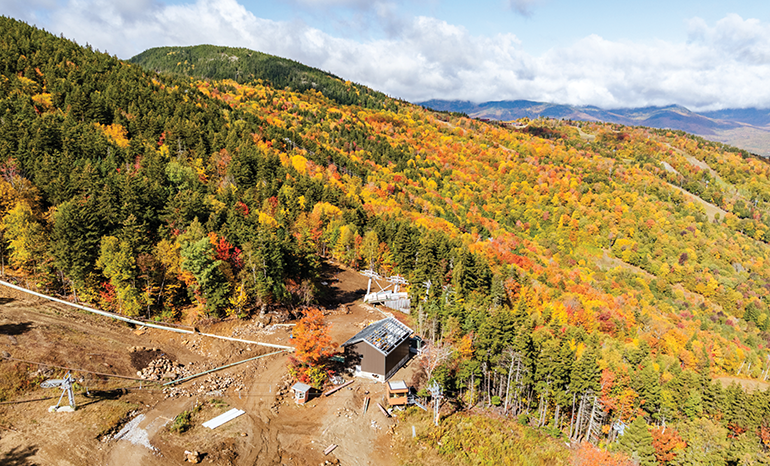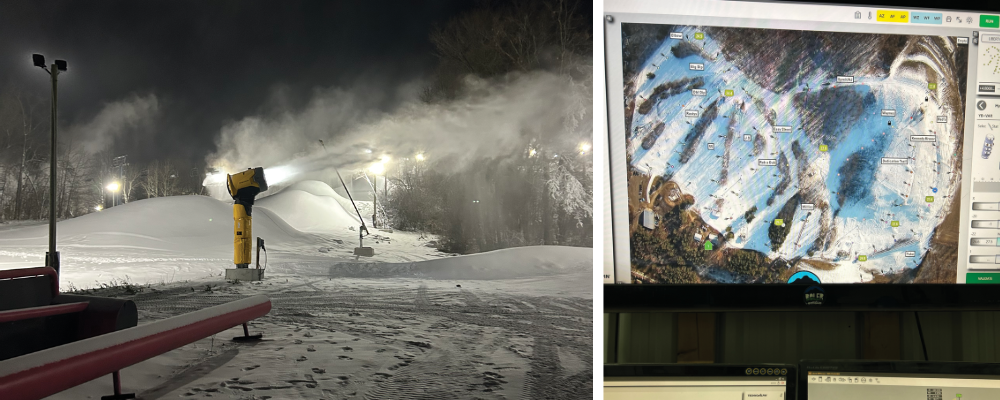Snow guns roared on Copper Mountain’s Oh No Bowl, blanketing the upper reaches of the Colorado resort in white ahead of the U.S. Ski Team’s first day of downhill training. It was October 2011, and the resort was preparing to host the team for the first time. Mike Looney and his crew of snowmakers watched snow guns coat the piste just uphill of where they were installing new pipe, working fast and hard to stay ahead of it. The snowmaking process followed the installation downhill, becoming a methodical dance in a race against time, with the opening date looming.
“That very first year we had the USA downhill track was one of my proudest moments,” recalls Looney, Copper Mountain senior slope maintenance and snowmaking manager. “We were making snow above and welding pipe and digging below. As we moved down the hill with snowmaking, we were just finishing up the welding and installation at the bottom.”
The team was installing new hydrants and snowmaking infrastructure on 10,000 feet of steep, rugged race trail to support the early-season snowmaking plan, but the project began months behind schedule. Despite the stress-inducing push, the team pulled it off, opening the course in time to meet the late-October deadline.
For most ski areas, the annual early season push to get the hill open isn’t quite as stressful as Looney’s experience more than a decade ago, but knowing overall goals and priorities and having a plan to achieve them can result in a similar sense of accomplishment.
There are several factors that dictate where ski areas make snow first. Let’s explore what goes into these decisions, how early-season snowmaking plans can inspire major capital improvements, and and other influences.
Early-Season Priorities and Goals
Ski areas’ early-season snowmaking priorities vary widely. They often depend on climate, lodging options, scheduled events, and the team’s overall goals for opening the mountain. For some ski areas, like Copper, early-season training and events are major factors when determining what trails need to open and when. Other ski areas simply want to get skiers and riders to the hill as soon as possible.
“A closed resort is hard to make money with,” says Thomas Budd, snowmaking manager at Sunday River, Maine. “If we can open faster, we can move to new terrain faster. If we move to new terrain faster, it increases our acreage. Starting the process early gives our customer base the best ski experience possible.”
Sunday River's strategic plan: full-service opening. Sunday River is traditionally one of the first ski areas to open in the East thanks to a snowmaking system that can pump upwards of 11,000 gpm. This has its advantages from a marketing standpoint, but it’s also a good opportunity to train newer snowmakers out on the hill.
The resort is more than three miles from boundary to boundary. Prior to recent upgrades, snowmaking on Jordan, the westernmost peak, happened later due to the time it took to charge the system out there, which meant the slopeside Jordan Grand Hotel and its restaurants were slow early season. But thanks to recent major snowmaking infrastructure improvements, snowmakers now start at Jordan and capitalize on its higher elevation, large parking area, and eight-pack chairlift. This allows the resort to start generating income earlier from Jordan’s ski-in ski-out lodging and on-site restaurants.
Snowmakers work on the Locke Mountain zone—historically the first zone to open—simultaneously with Jordan, to offer New England ski teams an early-season training venue, another revenue-generating opportunity. The two separate zones can then be connected during the next phase of the snowmaking plan.
 Two new booster stations, including the one above, since 2022 enable Sunday River, Maine, to make early-season snow in two zones: Locke for athletes and Jordan for hotel guests.
Two new booster stations, including the one above, since 2022 enable Sunday River, Maine, to make early-season snow in two zones: Locke for athletes and Jordan for hotel guests.
Boler Mountain’s strategic plan: maximize all windows. Of course, not all ski areas have the infrastructure or means to open in early November. Boler Mountain, a small urban ski area in southern Ontario, also prioritizes opening as soon as the forecast allows, but fleeting weather windows often result in mid-December openings.
Boler’s snowmaking system is set up to always use its entire pumping capacity of 1,500 gpm across its 50 skiable acres. At marginal temperatures, the only way to max out capacity is to utilize all guns. This also maximizes fleeting weather windows—an endeavor made easier by a fully automated snowmaking system and high gun density—to get the mountain open as quickly as possible.
The colder it gets, the narrower the focus becomes, i.e., more flow through fewer guns while maintaining the maximum pumping capacity. “If the wet bulb temperature gets colder [than 28 degrees Fahrenheit], we shut guns off and put more volume out of other guns that are operating,” says director of operations Marty Thody. “If we were to go below 20 degrees wet bulb, we’d focus on just a few trails on the east peak.
“Our gun density is so high that our run time per trail really shortens up,” he adds. They’ll switch gears during the rare occasions it gets even colder, focusing on only two or three of their highest-priority trails around each of their three lifts.
Overall, the team’s goal is to open as much top-to-bottom terrain as quickly as possible. However, extended periods of cold temperatures during the early season are a rarity at Boler, meaning the weather dictates the initial snowmaking plan. When temperatures allow the team to narrow their focus, they’ll make enough snow to slide on in one area before moving on to expand open terrain, and then return to build up the base in each zone.
Greek Peak: be prepared to pivot. New York’s Greek Peak, which similarly deals with touch-and-go early season weather windows, typically focuses first on its base area learning center and two or three trails off its main lift, including a green, blue, and black trail (which is also its race trail).
Of course, a combination of weather conditions and timing relative to opening day can force a change in plans. For example, two years ago, after a stretch of mild weather limited snowmaking production, the ski area took advantage of an exceptionally cold weather window by focusing all its resources on one green trail, using two guns on every hydrant to guarantee top-to-bottom beginner terrain on opening day.

Planning Ahead
While going into the season with specific snowmaking priorities is integral to a smooth and successful opening, planning further ahead can also simplify the process.
Marquette's multi-year plan. The team at Marquette Mountain, Mich., aims to open during the first weekend in December. In the past, it has prioritized one beginner trail and two race runs to satisfy early-season race obligations. This year, though, major upgrades will allow it to add a popular blue run to the opening snowmaking agenda.
“We were putting a lot of focus on getting the green run open because it’s a top-to-bottom connection from our Snowfield trail,” says general manager Kaet Johnson. “But the blue run is a much more direct connection, and it’s the run our locals want.”
Accomplishing this has been a long-term project. It involved four years of ongoing infrastructure upgrades, including $1.5 million of improvements in summer 2025 with 8,000 feet of new pipe and power lines to feed several new fixed and mobile TechnoAlpin TT9 and TR9 fan guns and one TL8 lance. This investment will facilitate a faster opening and sustained coverage for the season.
And there was more to the plan. “We have a couple of areas that are very hard to get to with a mobile gun when there's no snow on the ground,” Johnson explains. “So, we staged a couple of guns last season, while we had snow. Now we won’t be dealing with the logistics around getting them there safely, which is tough because it's a rock face.”
The 15-foot mobile SMI lances, staged above the rock face, were slowly transported on snowcat blades, with care taken to avoid damage from a bumpy ride. That would be an impossible task with no snow on the ground. Planning ahead will allow the area to fire up the guns as soon as they have the opportunity and also avoid a major headache.
 Left to right: To support athlete training, Copper Mountain, Colo., first makes snow on the trails off the Super Bee lift, part of the U.S. Ski Team Speed Center and Alpine Tech Center; Marquette Mountain, Mich., added several new fixed and mobile fan guns to enable snowmakers to add a popular blue run to the opening day snow plan.
Left to right: To support athlete training, Copper Mountain, Colo., first makes snow on the trails off the Super Bee lift, part of the U.S. Ski Team Speed Center and Alpine Tech Center; Marquette Mountain, Mich., added several new fixed and mobile fan guns to enable snowmakers to add a popular blue run to the opening day snow plan.
Infrastructure Refinements
Investing in a reliable and effective snowmaking system is the quickest path to achieving early-season opening goals and accomplishing what your snow plan sets forth.
Innovations at Boler. Boler Mountain's entirely automated system has been a game changer, says Thody. “Once the wet-bulb temperature hits 28 degrees, we’ll go online at 100 percent capacity, even if it’s only for 45 minutes,” he explains. “You couldn’t do that without automation—it only takes us a few minutes to use 100 percent of our resources.”
According to Thody, the snowmakers take advantage of any window they can get after the first week of November, even when there’s rain or warmth in the forecast. “If we lose 50 percent of the product we’ve produced, we’re still 50 percent ahead of the game,” he says. “Worst case, we’ll only have 20 percent of the product remaining after a negative weather event, but at least we’re moving forward.”
Other key infrastructure components contribute to opening as early as possible. Boler’s system employs a strategic mix of mostly HKD and TechnoAlpin sticks and fan guns. Thody says their fan guns are primarily staged in open areas that need more snow, and stick guns serve the narrower sections of trails. The area also has a WeSnow 120 all-weather snowmaking machine (now supported by HKD) staged in a high-wind area to ensure coverage there from the start. Typically, the crew will fire up the all-weather machine in late October and run it constantly into January.
Boosting and frost-free in Maine. Sunday River’s snowmaking team changed the game by installing frost-free pipe and two booster stations over the last four years. The newest booster station, which will debut this ski season, utilizes refurbished pumps that were replaced during the previous booster project. These boosters give the team the ability to drop the system’s pressure in order to increase the water flow rate.
“We operate our system with a dynamic approach where we will set the water pressure in order to maximize our flow rate,” says Budd. “With this booster, we don't need to necessarily run at 950 psi anymore. We can drop that to around 800 psi in order to boost our usable water by about 2,000 gallons per minute.”
The boosters, along with 20,000 feet of 20-inch frost-free pipe—snowmaking pipe buried below the frost line—installed during the summers of 2022 and 2023, have made it easier to maximize early season snowmaking windows because the system can be charged more quickly. What used to take hours now takes minutes.
“I can pre-charge water going out to Jordan and in about 20 minutes have those trails fully charged and ready to make snow,” says Budd. “Now we can take advantage of early season cold snaps out on Jordan, whereas before, we were kind of restricted to Locke because it took so much effort to charge on Jordan. It used to be one of the last places we [made snow].”
 Left to right: The fully-automated snowmaking system at Boler Mountain, Ontario, pumps 1,500 gpm at all times and allows the area to take advantage of even brief snowmaking windows; Boler’s system controls display a bird’s-eye view of the entire ski area with gun locations overlaid on the image.
Left to right: The fully-automated snowmaking system at Boler Mountain, Ontario, pumps 1,500 gpm at all times and allows the area to take advantage of even brief snowmaking windows; Boler’s system controls display a bird’s-eye view of the entire ski area with gun locations overlaid on the image.
Staffing
For the sake of efficiency and economics, many ski areas utilize a small team of year-round snowmaking staff to do maintenance and prep, and then bring on the full seasonal team just before consistent snowmaking conditions arrive. At Greek Peak, for example, which has a snowmaking team of around 20 people, seasonal foremen return in October to start setting up the equipment, and snowmakers usually come in to train a week before snowmaking starts.
Infrastructure impacts staffing needs. The snowmaking infrastructure a ski area has in place directly affects staffing. According to Greek Peak snowmaking supervisor and assistant operations manager Jarret Dulemba, recent infrastructure upgrades have helped with staff retention and cut down on staffing costs. The upgrades include valving that allows targeted system isolation, additional hydrants and piping, fixed low-energy snowmaking guns, and an additional 1,250 gpm of pumping capacity.
“We’re closing the gaps between hydrants, so now we have one every hundred or so feet,” says Dulemba. “So instead of doing long stretches, we’re putting less wear and tear on the groomers, and we have less guys moving guns around. And instead of relying on moving portable guns, we have fixed assets right on the side of the trail, cutting down on the time to it takes to pull off one trail and go to another.”
With the lower stress and fatigue the crew experiences as a direct result of infrastructure upgrades, Dulemba has decreased his crew size from eight people to six on a single shift. In addition, Dulemba notes that 15 members of this season's 20-person staff have returned from last season, an indication that the resort's overall plan is succeeding.
Proper tools + clear plan + happy employees = successful snowmaking. Snowmakers who enjoy what they do is just one more piece in the puzzle of early-season snowmaking. Giving them the proper tools they need, like a clear plan and updated and efficient infrastructure, keeps everyone happy.
“One of the highlights of being the snowmaking manager is leaving the guys at night, coming back early the next morning, and seeing the smiles and pure joy on their faces,” says Dulemba. “When there are snowmakers working on the hill, you get customers hooting and hollering, showing their appreciation. It’s very rewarding.”





